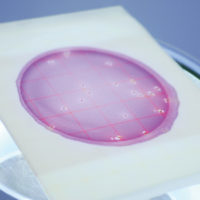Olive oil is a delicious and versatile staple in any cook’s pantry; it is used not only for its flavor but also for its health benefits, as it contains lots of healthy fats and antioxidants, making it a staple in the Mediterranean diet. Olive oil is also used in a variety of beauty products. Because of the popularity and high demand for good-quality olive oils, it’s not uncommon to hear of olive oil being adulterated with cheaper vegetable oils and lower-grade olive oils. In order to prevent fraud and ensure the health and safety of consumers, quality tests are needed to authenticate the product quality and purity.
There are several grades of olive oil sold on the market with differing nutrient and antioxidant activity, quality, and chemical composition:
• Virgin olive oil is the juice of freshly harvested olive fruits.
• Extra virgin olive oil is of the highest quality based on both sensory and physical—chemical characteristics.
• Refined olive oil is oil that has been chemically purified.
• Commercial olive oil is a blend of virgin and refined oils.
• Pomace olive oil is obtained from the solid remains of olives already pressed for juice using solvent extraction.
For producers who need to “see” what’s in that olive oil to ensure its purity, it has not traditionally been a simple and straightforward process to quantify fatty acid and sterol profiles in-house, so samples are typically sent out to dedicated labs for testing, which can be costly to producers. An alternative target that can be used to characterize olive oil is its triacylglycerol (TAG) profile since TAGs are the most abundant class of compounds in edible oils. TAG analysis is attractive since it requires less sample prep and extraction prior to analysis. However, TAG profiling for olive oil is not common since the compounds are difficult to resolve with traditional high-pressure liquid chromatography (HPLC) and usually difficult to detect with easily accessible detectors such as ultraviolet-visible (UV/Vis) spectroscopy. Luckily, there is an alternative detector that has been used to “see” the TAG profile—a charged aerosol detector (CAD).
What Is a CAD?
CAD is a universal mass-sensitive detector that is used to quantify any nonvolatile and many semivolatile analytes with LC. Most LC detectors require certain physicochemical properties to detect a substance, such as a chromophore for UV light absorption or ionizability for mass spectrometry. However, CAD provides consistent analyte response independent of chemical structure and molecule size, with a dynamic range of up to four orders of magnitude from a single injection (subnanogram to microgram quantities on the column).
CAD technology delivers performance that refractive index, low wavelength UV, and evaporative light scattering detectors simply cannot match. A CAD helps you see analytes that other technologies fail to detect.
What Are Some of the Key Benefits of Using CAD?
• CAD offers near-universal detection of any nonvolatile and most semivolatile analytes, as it relies on the charge transferred to the particles and does not rely on physicochemical properties. This means that it’s okay if your analytes that lack chromophores (required for UV/Vis) or ionize poorly (for mass spectrometry).
• CAD gives predictable responses, which allow for the measurement of analytes in direct proportion to their relative amounts and for the use of single calibrant quantification. This is a unique benefit that allows for relative quantification of any compound, even unknowns, in the sample without actual standards.
• CAD has been used for a huge range of applications, from food and beverage to pharma and biopharma to environmental applications.
• CAD can give more insight into the sample with little to no additional work, as it can be coupled in-line with other detectors for complementary data.
In addition to all these analytical benefits, CAD is also accessible, easily integrated into a workflow, and easy-to-use.
More about Olive Oil Purity
TAG profiling for olive oil can be done more easily with a CAD detector to help quickly confirm the purity of the final product with less sample preparation in a more environmentally friendly manner compared to traditional analyses.
Interestingly, olive oil’s ability to infuse with other flavors has recently been explored for cannabidiol, also known as CBD. This is where CAD’s versatility can be used not only to check the quality and purity of the olive oil but also to quantify a panel of synthetic cannabinoids without direct reference standards.[1]
Be sure to read this customer case study and application note about the experience that the Olive Center at the University of California – Davis had with using the Thermo Scientific™ Vanquish™ Flex Ultra HPLC with CAD system that they nicknamed “Wonder Woman.”
Learn more at www.thermofisher.com/CAD.
Reference
1. Poplawska, M, et al. 2018. Forensic Toxicol 36:122–140
Simplifying Olive Oil Analysis



